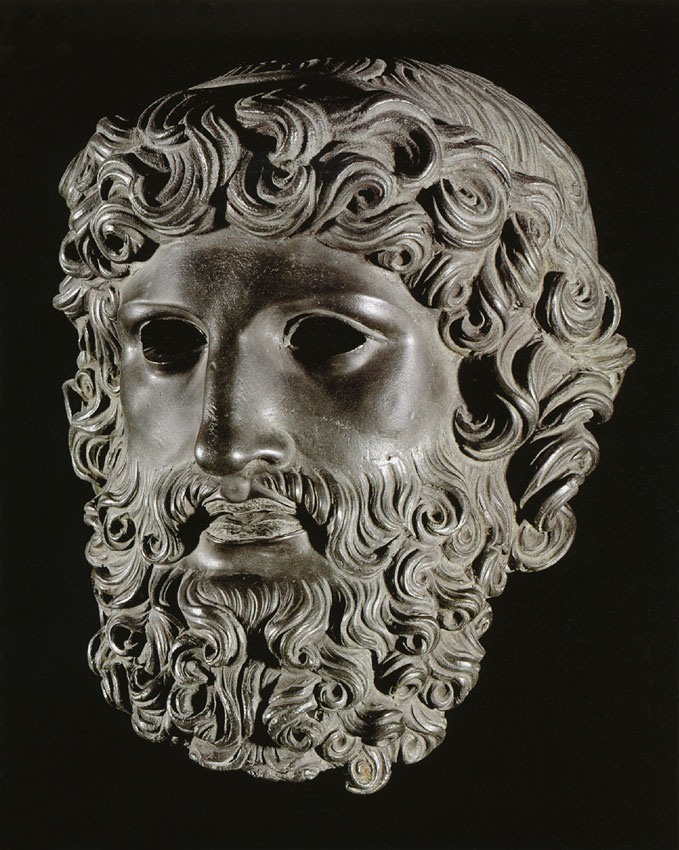
Head of Jupiter
Bronze, pollow cast. Roman, 1st century CE.
Inv. No. VI 9.Vienna, Museum of Art History
Head of Jupiter.
Bronze, pollow cast. Roman, 1st century CE.
Inv. No. VI 9.
Vienna, Museum of Art History
(Wien, Kunsthistorisches Museum).
Description:
This well-preserved head comes from the collection of Archduke Ferdinand of Tirol at Ambras Castle. It was originally part of a statue, as may be seen from traces of solder where the neck joined the body. Identical with the Greek god Zeus, Jupiter was the ruler and protector of gods and men; the diadem in his hair is an external sign of this high office. The head is framed by carefully fashioned curls that fall across the forehead and extend down the cheeks to his beard. The face is characterised by a low and slightly arched forehead, raised eyebrows, smooth cheeks, a straight nose with elegant nostrils, and a slightly open mouth. The eyes were originally made of another material (stone, glass, ivory) and set in. The rough surface of the lips was covered with thin copper or silver foil, considerably intensifying the effect. The head makes a cool and static impression on the observer; despite the elegant shapes, it appears stiff and hard. It is a work of Roman eclecticism of the early imperial period but oriented on Greek models of the 5th century BC.
Traces on the inside of the head show that it was made in the indirect hollow-casting technique called the lost-wax process. This technique was developed by Greek bronze casters in the 5th century BC. Its advantage compared with the direct process of solid or hollow casting was that the model was not destroyed in the process. Starting with a basic model in clay, impressions are made in clay or plaster, creating several partial moulds to which hot wax is applied. When the wax has cooled, the moulds are removed and the wax parts are assembled for the casting process. Large bronze statues as well as larger statuettes could be cast in several parts by the use of this technique. The individual pieces were then soldered together.
Traces on the inside of the head show that it was made in the indirect hollow-casting technique called the lost-wax process. This technique was developed by Greek bronze casters in the 5th century BC. Its advantage compared with the direct process of solid or hollow casting was that the model was not destroyed in the process. Starting with a basic model in clay, impressions are made in clay or plaster, creating several partial moulds to which hot wax is applied. When the wax has cooled, the moulds are removed and the wax parts are assembled for the casting process. Large bronze statues as well as larger statuettes could be cast in several parts by the use of this technique. The individual pieces were then soldered together.
Kurt Gschwantler
Credits:
© 2006. Photo, text: A Brief Guide to the Kunsthistorisches Museum. Edited by Wilfried Seipel. Vol. 4. Masterpieces in the Collection of Greek and Roman Antiquities. Kunsthistorisches Museum. SKIRA, 2006, p. 68, cat. 21 (ISBN 3-85497-099-4).
Keywords: γλυπτική sculptura sculpture sculptural scultura skulptur ρωμαϊκό roman romana romano romani römisch römische römisches römischen römischer romain romaine romains romaines ρωμαϊκό αντίγραφο copy copia kopie copie χάλκινο bronze bronzo bronzeo bronzen γιούπιτερ jupiter iupiter juppiter iuppiter jovis iovis jove giove head of pollow cast zeus inv no vi 9